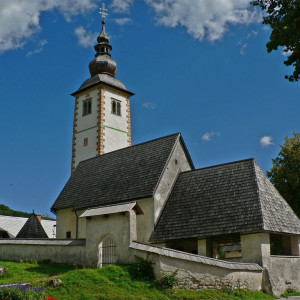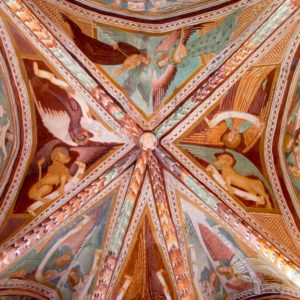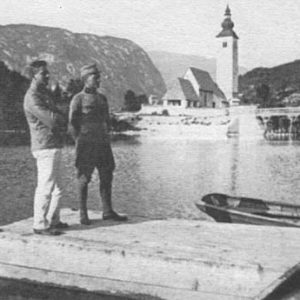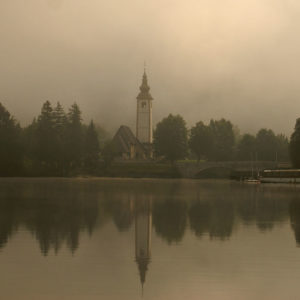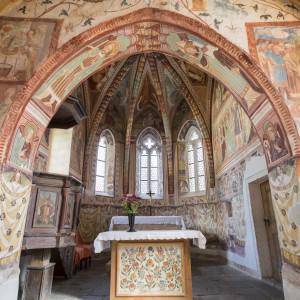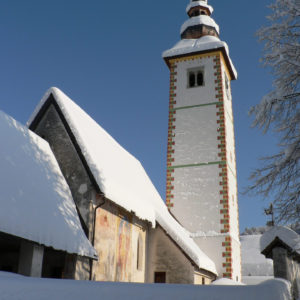The picturesque church of St. John the Baptist is a branch of the parish of Srednja vas in Bohinj. It stands on a hill by Lake Bohinj and, together with the stone bridge, is one of Bohinj’s greatest attractions. It was built before 1300 and is an important cultural and historical monument, which is why it is also protected.
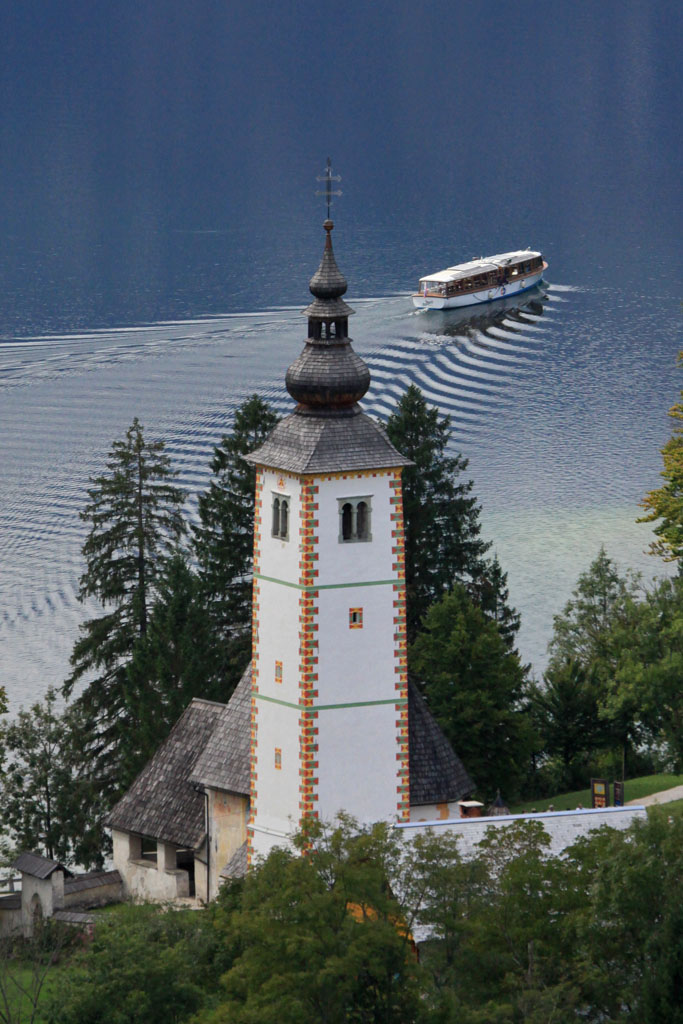
The 700-year-old church is one of the finest examples of Slovenian medieval architecture and mural painting.
Among the most iconic images and popular photographic motifs of Bohinj is the outstanding cultural and historical monument of medieval architecture – the Church of St. John the Baptist from 12. century. The impressive frescoes on the outside keep travellers safe, while inside they enigmatically challenge art historians and visitors alike, as these Gothic paintings are full of mysteries that are open to interpretation. Why do angels have teeth and why do they bare their teeth? Why are there two devils, both white? And you should definitely see the wooden head of John the Baptist, as there are only five of its kind in the world. Pay attention also to the simple chorus, which is a recording of the Bohinj balcony or “gank” in Bohinj dialect.
The picturesque church of St. John the Baptist is a branch of the parish of Srednja vas in Bohinj. It stands on a hill by Lake Bohinj and, together with the stone bridge, is one of Bohinj’s greatest attractions. It was built before 1300 and is an important cultural and historical monument, which is why it is also protected.
OPENING TIME
The Church of St John the Baptist will be open from 26.12.2023 to 2.1.2024, from 15.00 to 18.00
During this time, the nativity scene is on display (entrance fee is required)
Visits to the church for groups are only possible by prior arrangement on:
tel: +386 (0)40 237 812
w: https://www.janez-krstnik-bohinj.si/
Price list
- Adults: 3,50 €
- Students and pensioners: 2,50 €
- Children up to 12 years: brezplačno
- Family ticket: 7,00 €
- Group over 10 people: 3,00 €
- Julian Alps: Bohinj card holders: free of charge
- Adults: 3,50 €
- Students and pensioners: 3,00 €
- Children up to 12 years: free of charge
- Family ticket: 7,00 €
- Group over 10 people: 2,50 €
- Church and bell tower individual: 6,00 €
- Church and bell tower group: 5,00 €
- Professional guidance: 40,00 €
- The ticket price includes an audio guide.
- Entrance is free for Julian Alps Bohinj card holders.
Interesting facts
The church is in a variety of styles, from Romanesque to Baroque. The wooden head of John the Baptist from 1380, kept by the Institute for the Protection of Natural and Cultural Heritage, is very interesting. The frescoes, the oldest of which date from the 13th century, are also a landmark of the church century. There are also some 72 paintings of various saints and other motifs. On the southern outer wall, three paintings in three layers depict the three Sts. Christophers. This saint is the patron saint of pilgrims, travellers, drivers, porters, rafters and boatmen…
The Baroque bell tower, which was added to the church in the 18th century, together with the entrance porch, is also a special feature of the church . It is known for its double onion, lantern and shingle roofing. The church also contains three wooden altars from different periods of the 17th century century. Archaeological finds have been found in the area dating from 1. to 5. centuries after Christ.
White Devil
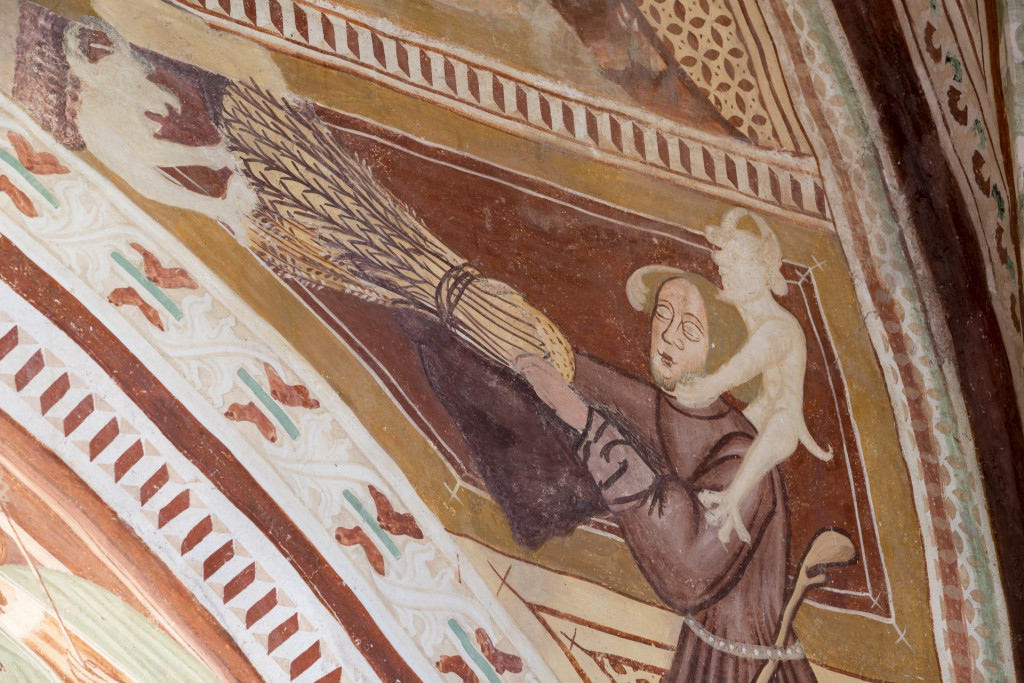
On the inside of the triumphal arch of the Church of St. John’s imagination is stirred by the white devil, who sits behind Cain’s neck and whispers murderous schemes to him. The famous French writer Jean Paul Sartre was also interested to see this special feature when he visited Bohinj in the 1960s.
Professor Marija Cvetek, still a student at the time, showed him and his companions around the church:
“And when they saw the white devil, some attributed the colour to mythological imagery, while others speculated whether the colour black might have faded over the centuries. When I remarked that it would have faded elsewhere, they thought that it probably had, but that it wasn’t as noticeable elsewhere as it was with the devil.”
Above the scene of Cain and Abel giving of their offerings to God, there is another scene from 15. century. This is St. George on a white horse, dressed in a knight’s costume, stabbing a great dragon with a spear. He rolled onto his back and clung to the horse’s legs. The battle takes place under the castle, where the King and Queen watch in awe, while Daisy kneels at the foot of the hill, praying for a happy resolution. On the north side of the presbytery we find another dragon, which St. Margaret is holding in her left hand, wrapped in a green garment. All these dragon representations of evil – the devil – have also been celebrated in the mythological tradition of the Bohinj people. Here it met and combined with biblical content and apocryphal legends, which were also brought by the visual artists. These mythological motifs are therefore crucial for reflecting on the indigenous folklore mythology that has made its way through millennia into today’s time and space.
Returning to the white devil and the white dragon’s tail (the fragment on the north inner side of the nave), their whiteness unintentionally reminds us of the awe-inspiring white creatures of the Bohinj fairy tales: the white women, the bêva (similar to Pehta – in Slovene folklore Pehta is a herbalist), the white serpent and, finally, the white Golden Horn. If these beings are benevolent, whiteness enhances their virtues, but if they embody evil, whiteness makes them more terrible. In world literature, this symbolism is embodied in Melville’s Moby Dick, the terrible white whale that terrified sailors and heralded their destruction.
(Prof. Dr. Marija Cvetek: The Bajeslovna Tradition in the Church of St. John by Lake Bohinj.)
Who was St. John the Baptist?
The Evangelists Matthew and Luke report Jesus’ assessment of him, “Truly, I say to you, among those born of women no one has risen greater than John the Baptist.” John was therefore greater than all the patriarchs and prophets of the Old Testament: the first were given the promises of the Messiah, the others predicted the Messiah. John the Baptist, however, was the forerunner of the Messiah, saw Him with his physical eyes, presented Him to the people, and baptized Him. It is understandable, then, why the Church celebrates this great man with two feasts that celebrate his double birth: on 24 June, it commemorates the solemn feast of his birth for this world and for the mission of Jesus’ forerunner, and on 29 August, it commemorates his martyrdom, his birth for heaven.
We know the story of his martyrdom from the Gospel accounts. Herod Antipas, the governor or tetrarch of Galilee and Perea, took to himself Herodias, his half-brother’s wife, who was also his niece. It disgusted everyone who had any sense of decency that Herod had married his brother’s wife while he was still alive. But John the Baptist, true to his prophetic ministry, fearlessly stood before Herod and said to his face, “You are not allowed to have her!” Luke the Evangelist writes that he also rebuked him for all his other wickednesses. Herod had neither the courage nor the strength to repent, but rather silenced the messenger of God: he had him thrown into prison in the impenetrable fortress of Maherunt by the Dead Sea.
Herod respected John, but he feared him even more. Herodias was especially afraid of him because the prophet threatened her position. After John had been in prison for almost a year, Herod celebrated his birthday in Maherunt. What we hear in the Gospel happened there. Herodias’ daughter Salome danced before Herod and his guests. He was so enchanted by the beautiful girl that he promised her – even intoxicated by wine – everything she could wish for. The girl was just an instrument of Herodias’ evil intent: she demanded the head of John the Baptist on her mother’s orders. Herod was puzzled by this request, but he wanted to show himself a man of his word and granted the girl’s wish.
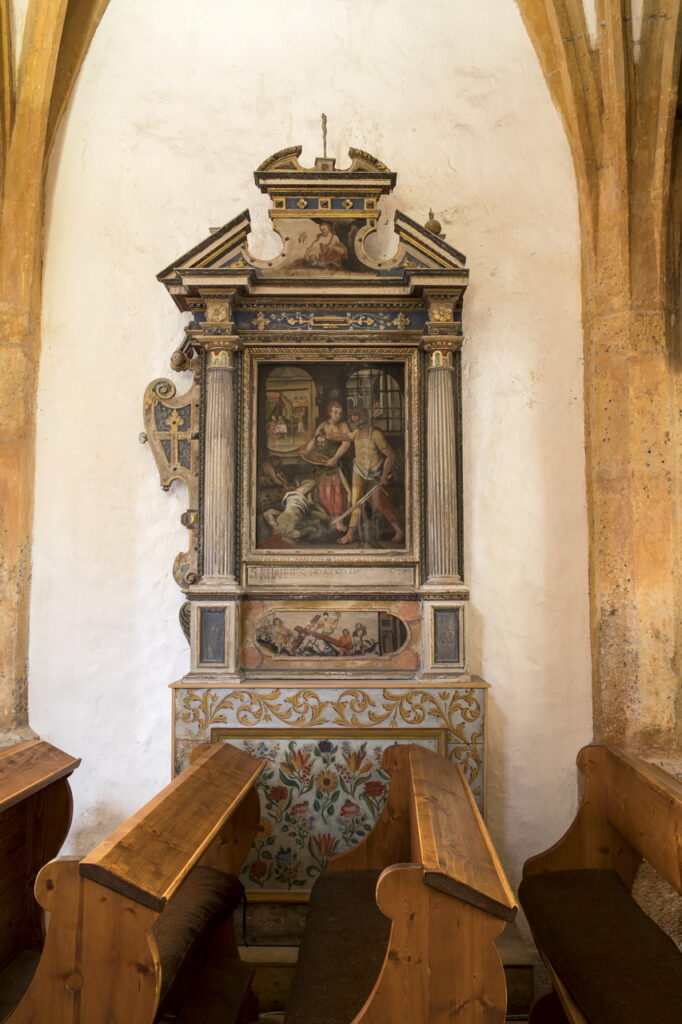
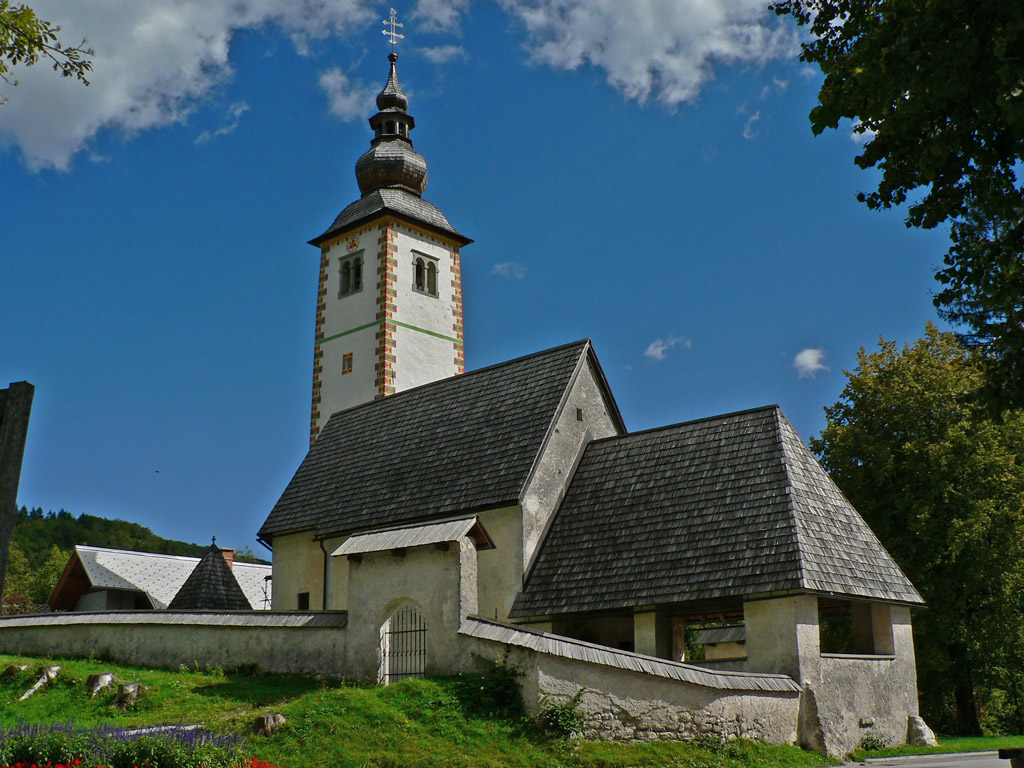
Fresco of St. Christopher
The patron saint of the Furmans is also painted on other churches in Bohinj, but only here we can see three frescoes of the saint in different layers. The first layer was painted around 1300, the second around 1400 and the third around 1530. People believed that the sight of St Christopher brought them a happy day.
A few more frescoes worth seeing:
- one of the oldest in Slovenia is the fresco of St John the Evangelist drinking poison in front of the priest Aristodemus
- the poorly preserved mysterious man with a hammer
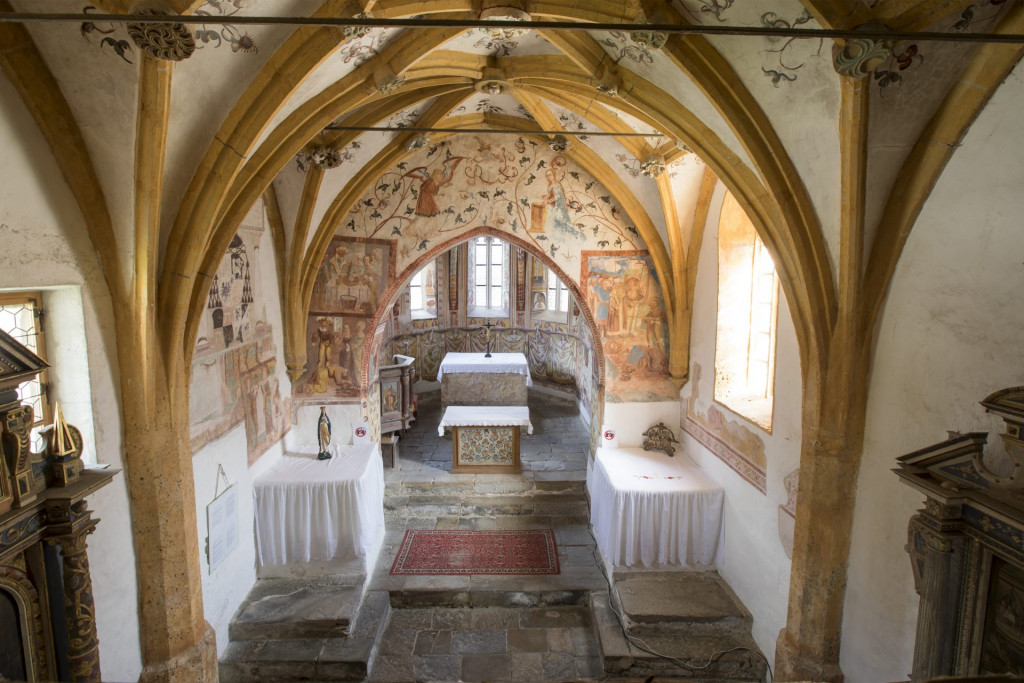
Church of Saint John the Baptist
tel: +386 (0)71 225 973
e: [email protected]
w: https://www.janez-krstnik-bohinj.si/


